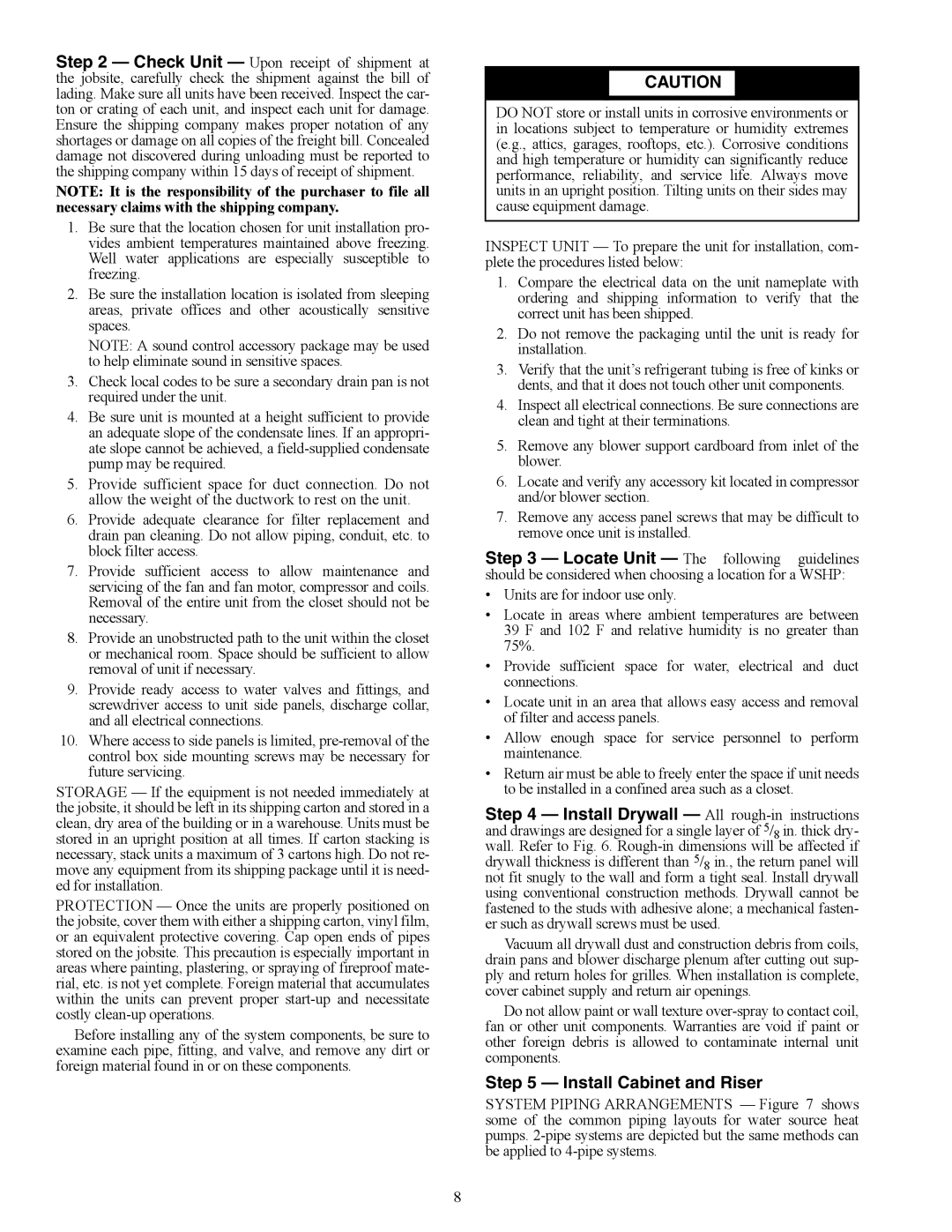
Step 2 — Check Unit — Upon receipt of shipment at the jobsite, carefully check the shipment against the bill of lading. Make sure all units have been received. Inspect the car- ton or crating of each unit, and inspect each unit for damage. Ensure the shipping company makes proper notation of any shortages or damage on all copies of the freight bill. Concealed damage not discovered during unloading must be reported to the shipping company within 15 days of receipt of shipment.
NOTE: It is the responsibility of the purchaser to file all necessary claims with the shipping company.
1.Be sure that the location chosen for unit installation pro- vides ambient temperatures maintained above freezing. Well water applications are especially susceptible to freezing.
2.Be sure the installation location is isolated from sleeping areas, private offices and other acoustically sensitive spaces.
NOTE: A sound control accessory package may be used to help eliminate sound in sensitive spaces.
3.Check local codes to be sure a secondary drain pan is not required under the unit.
4.Be sure unit is mounted at a height sufficient to provide an adequate slope of the condensate lines. If an appropri- ate slope cannot be achieved, a
5.Provide sufficient space for duct connection. Do not allow the weight of the ductwork to rest on the unit.
6.Provide adequate clearance for filter replacement and drain pan cleaning. Do not allow piping, conduit, etc. to block filter access.
7.Provide sufficient access to allow maintenance and servicing of the fan and fan motor, compressor and coils. Removal of the entire unit from the closet should not be necessary.
8.Provide an unobstructed path to the unit within the closet or mechanical room. Space should be sufficient to allow removal of unit if necessary.
9.Provide ready access to water valves and fittings, and screwdriver access to unit side panels, discharge collar, and all electrical connections.
10.Where access to side panels is limited,
STORAGE — If the equipment is not needed immediately at the jobsite, it should be left in its shipping carton and stored in a clean, dry area of the building or in a warehouse. Units must be stored in an upright position at all times. If carton stacking is necessary, stack units a maximum of 3 cartons high. Do not re- move any equipment from its shipping package until it is need- ed for installation.
PROTECTION — Once the units are properly positioned on the jobsite, cover them with either a shipping carton, vinyl film, or an equivalent protective covering. Cap open ends of pipes stored on the jobsite. This precaution is especially important in areas where painting, plastering, or spraying of fireproof mate- rial, etc. is not yet complete. Foreign material that accumulates within the units can prevent proper
Before installing any of the system components, be sure to examine each pipe, fitting, and valve, and remove any dirt or foreign material found in or on these components.
![]() CAUTION
CAUTION
DO NOT store or install units in corrosive environments or in locations subject to temperature or humidity extremes (e.g., attics, garages, rooftops, etc.). Corrosive conditions and high temperature or humidity can significantly reduce performance, reliability, and service life. Always move units in an upright position. Tilting units on their sides may cause equipment damage.
INSPECT UNIT — To prepare the unit for installation, com- plete the procedures listed below:
1.Compare the electrical data on the unit nameplate with ordering and shipping information to verify that the correct unit has been shipped.
2.Do not remove the packaging until the unit is ready for installation.
3.Verify that the unit’s refrigerant tubing is free of kinks or dents, and that it does not touch other unit components.
4.Inspect all electrical connections. Be sure connections are clean and tight at their terminations.
5.Remove any blower support cardboard from inlet of the blower.
6.Locate and verify any accessory kit located in compressor and/or blower section.
7.Remove any access panel screws that may be difficult to remove once unit is installed.
Step 3 — Locate Unit — The following guidelines should be considered when choosing a location for a WSHP:
•Units are for indoor use only.
•Locate in areas where ambient temperatures are between 39 F and 102 F and relative humidity is no greater than 75%.
•Provide sufficient space for water, electrical and duct connections.
•Locate unit in an area that allows easy access and removal of filter and access panels.
•Allow enough space for service personnel to perform maintenance.
•Return air must be able to freely enter the space if unit needs to be installed in a confined area such as a closet.
Step 4 — Install Drywall — All
Vacuum all drywall dust and construction debris from coils, drain pans and blower discharge plenum after cutting out sup- ply and return holes for grilles. When installation is complete, cover cabinet supply and return air openings.
Do not allow paint or wall texture
Step 5 — Install Cabinet and Riser
SYSTEM PIPING ARRANGEMENTS — Figure 7 shows some of the common piping layouts for water source heat pumps.
8
